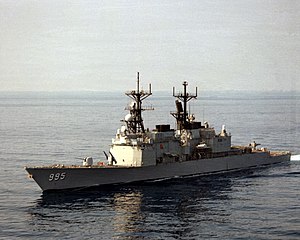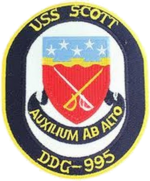 USS Scott underway on 21 March 1986
| |
| History | |
|---|---|
| Name | Scott |
| Namesake | Norman Scott |
| Builder | Ingalls Shipbuilding |
| Laid down | 12 February 1979 |
| Launched | 1 March 1980 |
| Acquired | 8 September 1981 |
| Commissioned | 24 October 1981 |
| Decommissioned | 10 December 1998 |
| Stricken | 10 December 1998 |
| Identification |
|
| Fate | Sold to Taiwan, 30 May 2003; commissioned as ROCS Kee Lung (DDG-1801) |
| Badge |  |
| General characteristics | |
| Class and type | Kidd-class destroyer |
| Displacement | 9,783 tons full |
| Length | 171.6 m (563 ft) |
| Beam | 16.8 m (55 ft) |
| Draft | 9.6 m (31.5 ft) |
| Propulsion | 4 × General Electric LM2500-30 gas turbines, 80,000 shp (60,000 kW) total |
| Speed | 33 knots (61 km/h) |
| Complement |
|
| Sensors and processing systems |
|
| Electronic warfare & decoys | AN/SLQ-32(V)3 |
| Armament |
|
| Aircraft carried |
|
USS Scott (DDG-995) was a Kidd-class destroyer of the United States Navy. She was named for Rear Admiral Norman Scott, who was killed during a surface action at the First Naval Battle of Guadalcanal (sometimes referred to as the Battle of Friday the 13th) aboard USS Atlanta, receiving a posthumous Medal of Honor for his actions.
Originally named Nader, Scott was ordered by the Shah of Iran, but was undelivered at the time of the Iranian Revolution and the U.S. Navy elected to commission her and her sister ships for service in the Persian Gulf. The destroyers were equipped with heavy-duty air conditioning and were also well suited to filtering sand and the results from NBC warfare. She was commissioned in 1981.
Scott completed a major re-fit in Philadelphia in 1988 that focused on upgrading its radar and fire control tracking system.
Scott was decommissioned from the U.S. Navy on 10 December 1998.